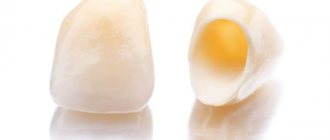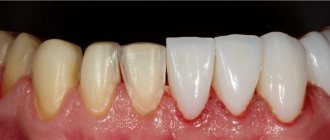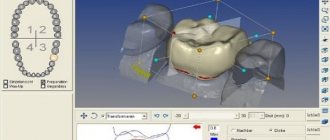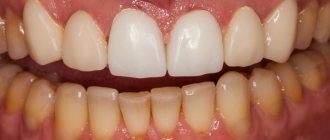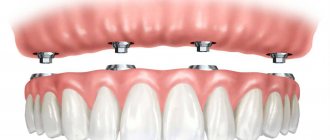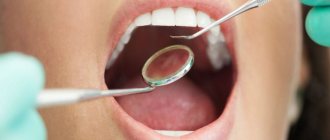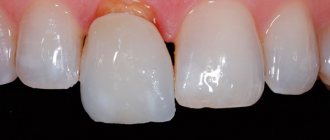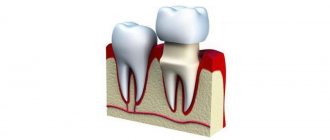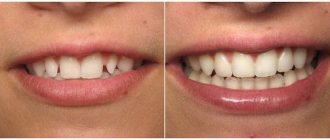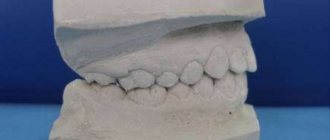Today we will talk about orthodontic structures such as temporary crowns .
We will discuss their features, types, indications for use, functional characteristics, materials from which they are made and installation steps.
We will also pay attention to the service life of these prostheses, why they are needed and much more on this topic.
Temporary crowns are a separate type of dental elements that are installed in place of a permanent crown while it is being manufactured.
What does a temporary crown do?
Such solutions have several functions:
- filling the dentition – improving the aesthetics of the smile;
- support and formation of a normal gum contour;
- prevention of malocclusion and displacement of adjacent teeth;
- protection of the empty area of the unit from infection and mechanical damage;
- ensuring the ability to chew food normally;
- preparation for the subsequent installation of a permanent prosthesis: it allows you to practice speaking and eating;
- correction of diction.
Recommendations for care.
No matter how well the prosthesis is made for you, take into account the fact that it can crack or even break. To prevent complications and not waste money on a new “cap,” treat the crown carefully and follow the basic rules for its operation:
- Do not forget about daily hygiene, brush your teeth thoroughly, delicately treating the area where the prepared unit is located, try not to put too much pressure on it.
- Eliminate sticky and too hard foods from your diet.
- Do not put too much stress on the part of the jaw where the structure is located.
How are crowns made?
The crown can be formed by a doctor directly in the patient’s mouth from silicone or acrylic. The second method is production in the laboratory using special plastic. This solution is more reliable: the material itself is stronger.
The structure is attached to special cement, which softens over time, making it easy to remove the temporary solution if necessary.
It is important that the shade of the material is selected in accordance with the color of the person’s natural teeth. Thanks to this, the replacement looks natural and allows you to smile freely, which is especially important when it comes to anterior unit prosthetics.
Materials
Most often, temporary plastic crowns are installed, but the following materials are also used:
- composite;
- metal-plastic;
- metal composite.
The last two are rarely used in modern dentistry and mainly for restoring teeth in the chewing group. It should be noted that plastic, compared to composite, is more fragile and easily stained; it is not recommended to wear it for a long time, because due to its porous structure, it can allow bacteria to enter.
Composite materials are more durable and highly resistant to food coloring. But such material will cost a little more. For both composite and plastic, use longer than 6 months is not recommended. Metal-plastic and metal composite have a longer service life, about 1.5 years.
Is it possible to do without a temporary crown?
According to dentists, it is undesirable to leave a prepared (ground) tooth or implant without “cover.” If the tooth is anterior, this inevitably creates communication problems. The patient hides his smile and tries to meet other people less often. This can negatively affect your mood.
For some patients, it is important to always maintain the aesthetics of their smile: managers, politicians, actors, singers, teachers find it difficult to work fully if a gap forms in the dentition. The method of installing a crown helps you to lead a normal life all the time, not to give up meeting people, entertainment, and not to change your plans.
Life time.
As has already become clear, this device is intended only for a short period of use and for the purpose of replacing a cosmetic defect and restoring the functionality of the jaw. Typically, plastic products last no more than 6 months, and composite ones up to a year. Therefore, you are unlikely to be able to extend the shelf life of the “caps”, and if you do not follow the operating rules, you risk reducing it altogether. When wearing crowns for a long time, their surface wears off, which is why neighboring healthy teeth begin to shift towards the ground unit, and the aesthetics of artificial systems leaves much to be desired. It is not recommended to delay the next stage of prosthetics, and as soon as the main onlay is ready, replace it.
What to do if the crown falls out.
As mentioned earlier, the crown may fall out, this is due to a number of factors, but the main reason is the adhesive, which is prone to dissolution. Because the overlay is assigned only temporarily; a specialist cannot fix it on a permanent basis. It does not fit tightly enough to the surface of the tooth, so it can slip off. In this case, you cannot try to return it to its original place yourself using improvised means. For example, plasticine, toothpaste or household glue. Not only will you damage the crown, but you will also cause serious harm to the ground molars and incisors. If this happens to you, it is recommended to do the following:
- First, call your doctor and explain the situation, make an appointment for correction.
- If your dentist cannot help you at the moment, rinse the crown and carefully place it back in your mouth (without using any aids, of course). Even in this form, it can at least somehow protect your tooth. When eating and before going to bed, you need to put it in a glass of warm water, continue these techniques until your visit to the doctor, and if it drags on, contact another specialist.
Important! Do not ignore this problem and resolve it as soon as possible. In the worst case, the infection will get into the pulp of the tooth and it will become inflamed, which may lead to its removal.
How long can you wear a crown?
Typically, it takes three to ten business days to produce a permanent structure. It is for this period that the installation of a temporary crown is designed. It is considered optimal to wear it for no more than seven days.
Since the materials from which it is made are quite fragile, they wear out quickly. Within twenty days the material will be completely erased. And this will lead to the risk of displacement of neighboring units, malocclusion and other unpleasant consequences. In addition, plastic absorbs dyes.
It is important to remember that such a design made of simple material is only a compromise solution, and it is not capable of fully performing all the functions of the tooth. Therefore, wearing it longer is not recommended.
If for some reason it falls out while being worn while the permanent crown is being prepared, the dentist can install a new one.
What are they made from?
For the manufacture of dental temporary crowns, materials with low strength are used, which can be removed or removed from the surface of the tooth without injury. In addition, the use of expensive materials is not advisable, because the service life is on average 2-3 weeks.
Temporary crowns are made from materials:
- acrylic composition;
- plastic;
- composites.
The material used for the manufacture of dental orthopedic products must meet the following requirements:
- the hardening process occurs quickly, but the specialist has enough time for application and correction;
- melting is performed exclusively at low temperatures while maintaining the strength of the product.
The temporary crown must be safe for the patient and perform its functions taking into account the anatomical features of the jaw. If the design causes significant discomfort or causes an allergic reaction, it must be replaced.
How to care?
When wearing such a design, the patient is advised to follow certain rules.
- It is advisable to exclude hard and viscous foods from the menu.
- You need to brush your teeth with a soft brush, carefully, without too much pressure.
- If you have several temporary crowns, chew alternately on some areas and then on other areas so that the time is approximately the same.
- If there is only one temporary crown for an implant or tooth, it is better to chew food on the other side of the jaw.
Indirect method
The indirect manufacturing method of crowns involves obtaining a high-quality product that has a more aesthetic appearance and is characterized by significantly increased reliability indicators. The cost of such a product will be higher.
Making individual temporary crowns using the indirect method takes up to two days. The process takes place in three stages:
- taking a silicone impression;
- making a plaster jaw model;
- casting a polymer crown;
- correction of the product using a plaster model using modern technologies.
Models of temporary crowns when manufactured indirectly correspond to the anatomical features of the dentition, so they do not cause discomfort and problems with chewing food.
Rules for wearing, care and adaptation
Temporary prosthetics are created very quickly and are not highly accurate, and naturally, the patient may feel some discomfort after its installation. Most often, such a prosthesis will interfere a little when closing the jaws. It is recommended that you tell your doctor about all the inconveniences, who will make adjustments and make it more comfortable and convenient.
Since temporary cement is used for fixation, the provisional prosthesis is not very securely fixed in the oral cavity. Therefore, to protect it (and the tooth itself), some precautions should be taken:
- avoid eating “stretchy” foods: toffees, chewing gum, etc.,
- reduce the chewing load on the temporary prosthesis: it is better to chew food on the opposite side,
- avoid eating solid foods
- Carry out hygiene procedures with caution: use threads especially carefully. An irrigator that gently and efficiently removes pieces of food from the interdental spaces will be a good help.
Modeling and installation of temporary structures
Provisional crowns are made in two ways: direct and indirect. The first makes it possible to receive the finished product within an hour.
- The orthopedist takes a silicone impression.
- Grinds the tooth.
- Plastic is poured into the impression and placed on the prepared tooth.
- Then the impression is taken. The hardened plastic product remains in place.
- The orthopedist can only grind off the excess, grind and polish the new one.
The indirect method is used in laboratory conditions, using silicone, plaster and wax. This method gives more effective results. A temporary crown best matches the anatomy of the patient’s jaw; it is more reliable and durable.
Purpose
During prosthetics, the procedure of tooth preparation is carried out and temporary crowns are necessary to protect the oral cavity from unwanted and even harmful influences; in addition, such crowns allow you to maintain the aesthetics of the dentition after grinding problem teeth. It should also be taken into account that when installed on the teeth, they relieve the patient from discomfort, since ground molars lose their main functionality, and also make it possible to correctly distribute the load during implantation.
What to do if it falls out?
It happens that the installed temporary crown comes off. It is quite natural that patients are concerned about this situation and if it has happened, what to do next? First of all, there is no reason to panic; you should return it to its place yourself, fixing it with Vaseline or toothpaste and be sure to consult a dentist. The structure returned to its place on its own will, of course, not have the same strength and reliability, but it will still perform its basic functionality. It should also be remembered that it is better to remove the prosthesis before going to bed, this will avoid the potential serious consequences of its night loss.
Voice of the people
If we analyze the reviews of patients who resorted to installing plastic crowns, we can say that for many of them they became a real salvation. They are perfect for young girls who, due to their age, cannot yet install metal-ceramics and do not have complexes about their smile, for example, at school.
It is also noted that it is necessary to use plastic structures only on a temporary basis, since it is not possible to fit such a crown tightly onto the tooth, and it becomes a breeding ground for harmful microorganisms. Many patients say that as a temporary measure, such prostheses are almost an ideal solution to the problem, plus, their cost is quite affordable.
What are they and why are they needed?
When a tooth is destroyed by more than 60%, there is no way to do without prosthetics. This can happen if he:
- was affected by caries;
- broken;
- worn out.
Of course, you can try to fill the tooth, “finishing” it to its original shape, but the filling cannot withstand the loads that the teeth are subjected to when chewing food, and very soon it will simply crumble, and the remaining thin walls of the tooth may chip.
But creating a permanent prosthesis is not a quick task. Therefore, while it is being manufactured, a temporary one can be inserted in place of the missing tooth, which the patient will use at all stages of orthopedic treatment.
Designs for molars
Normal and nutritious human nutrition is impossible without chewing teeth, since the entire load during chewing food falls on them. Accordingly, as soon as the first problems with the condition of such teeth appear, you should immediately consult a doctor and arrange for the installation of dentures. However, it is necessary to understand that the choice of plastic crowns must be approached carefully and carefully; if you select unsuitable prostheses, this will not correct, but will only worsen the situation.
It is better to give preference to those prostheses that have the longest service life; we must not forget that the structures have to undergo very serious impacts and not the highest quality plastic can easily and quickly fail. Metal-ceramics and ceramics on paper look like a more preferable option, but, firstly, they are significantly more expensive, and, secondly, if you incorrectly calculate the bite or pressure force when installing them, then chips or cracks may form on the prosthesis, and this will cause serious inconvenience for the patient.
Advantages
Considering the somewhat lengthy treatment process, issues of the aesthetic appearance of the patient’s oral cavity acquire particular importance and significance; it is these considerations that dictate the need to use provisional crowns. Their key advantages are:
- no pressure on the supporting tooth, which allows the patient not to feel pain;
- such crowns provide the patient with excellent protection from gum growth and the effects of various microorganisms;
- the tooth does not shift;
- while wearing such a crown, the patient gradually gets used to the foreign body in his oral cavity;
- there is no violation of diction;
- to some extent, restoration of lost functions is carried out, albeit to a small extent.
